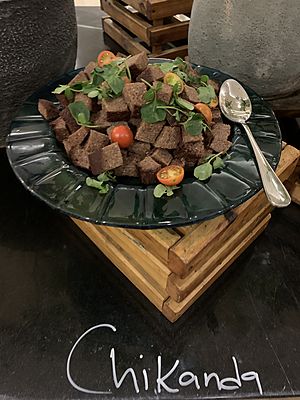Chikanda facts for kids

Chikanda
|
|
| Alternative names | Kinaka, Chinaka, Kikanda, African Polony, Zambian Polony, Zambian Sausage |
|---|---|
| Type | Snack, Dessert, Side dish |
| Place of origin | |
| Region or state | Southern Africa, East Africa |
| Main ingredients | Orchid tubers, Groundnut meal, Baking soda or ash water, Spices |
Chikanda is a unique and tasty dish from Zambia. It's made from the boiled roots, called tubers, of wild orchids. These special roots are also known as chikanda. Many people call this dish "African polony" because its texture is similar to bologna. You can enjoy Chikanda as a snack, a dessert, or even with nshima. Nshima is a thick maize flour porridge that is very popular in Zambia.
Contents
What is Chikanda?
Chikanda has been a popular food for hundreds of years. People in parts of Zambia, northern Malawi, and southwestern Tanzania have enjoyed it. This dish is especially important to the Bemba tribe in northeast Zambia. Even though it started with the Bemba, people all over Zambia eat it today.
For the Bemba, Chikanda is a big part of their culture. They often serve it at special events like weddings. Long ago, it was a food people ate when other foods were scarce in rural areas. Now, it's a popular food in cities too! You can find Chikanda sold by street vendors, in supermarkets, and even in big restaurants. City people really love this traditional rural dish.
In Malawi, some people believe that eating Chikanda can help protect them from getting sick. In southwestern Tanzania, there's a similar dish called kinaka. It's eaten by groups like the Nyamwanga and Fipa.
Ingredients for Chikanda
Many different kinds of orchid species are used to make Chikanda. Most of them come from the Disa, Habenaria, and Satyrium groups. Scientists have found that about 16 different orchid species are part of the chikanda trade.
The orchid roots look a bit like small potatoes. They are much smaller than a regular potato. To make Chikanda, people often add ash water or baking soda. These ingredients have a high pH, which means they are basic. They likely add important minerals to the dish. They also help give chikanda its unique firm texture and slightly soapy taste.
How is Chikanda Made?
Making Chikanda involves a few steps. First, the orchid tubers are dried out. Then, they are pounded into a fine powder. This brown orchid powder is mixed with groundnut meal. This mixture is then boiled to create a thick liquid, almost like a slurry. Sometimes, dried chili peppers are added for a bit of spice.
Next, soda is added to the mixture to make it thicker. Salt and other spices are also added for flavor. As the mixture simmers, it gets thicker and forms a cake. It even rises a bit, like dough when it bakes. Once it's ready, Chikanda is usually sliced and served.
Protecting Chikanda Orchids
The orchid roots used for Chikanda grow wild in Zambia. However, because so many people want to eat Chikanda, these orchids are becoming hard to find in the country. This high demand has led to a problem called overharvesting.
Now, orchids are often brought in illegally from countries like Tanzania, Angola, and the Democratic Republic of Congo. This means the orchids in those countries are also at risk of being overharvested. In the past, people had special ways to harvest the tubers. They would only pick tubers that had already spread their seeds. They also replanted the stalks to help new orchids grow. Sadly, these helpful practices have stopped because of the huge demand.
It's also very hard to grow these orchids on farms. So, scientists and conservation groups are working hard. They are trying to find ways to grow these threatened orchids to protect them. A similar problem happens in Turkey with salep, which is a starch used in desserts and drinks.

